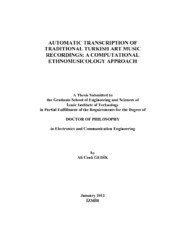Please use this identifier to cite or link to this item:
https://hdl.handle.net/11147/2926Full metadata record
| DC Field | Value | Language |
|---|---|---|
| dc.contributor.advisor | Savacı, Ferit Acar | - |
| dc.contributor.author | Gedik, Ali Cenk | - |
| dc.date.accessioned | 2014-07-22T13:48:37Z | - |
| dc.date.available | 2014-07-22T13:48:37Z | - |
| dc.date.issued | 2012 | - |
| dc.identifier.uri | http://hdl.handle.net/11147/2926 | - |
| dc.description | Thesis (Doctoral)--Izmir Institute of Technology, Electronics and Communication Engineering, Izmir, 2012 | en_US |
| dc.description | Includes bibliographical references (leaves: 96-109) | en_US |
| dc.description | Text in English; Abstract: Turkish and English | en_US |
| dc.description | xi, 131 leaves | en_US |
| dc.description.abstract | Music Information Retrieval (MIR) is a recent research field, as an outcome of the revolutionary change in the distribution of, and access to the music recordings. Although MIR research already covers a wide range of applications, MIR methods are primarily developed for western music. Since the most important dimensions of music are fundamentally different in western and non-western musics, developing MIR methods for non-western musics is a challenging task. On the other hand, the discipline of ethnomusicology supplies some useful insights for the computational studies on nonwestern musics. Therefore, this thesis overcomes this challenging task within the framework of computational ethnomusicology, a new emerging interdisciplinary research domain. As a result, the main contribution of this study is the development of an automatic transcription system for traditional Turkish art music (Turkish music) for the first time in the literature. In order to develop such system for Turkish music, several subjects are also studied for the first time in the literature which constitute other contributions of the thesis: Automatic music transcription problem is considered from the perspective of ethnomusicology, an automatic makam recognition system is developed and the scale theory of Turkish music is evaluated computationally for nine makamlar in order to understand whether it can be used for makam detection. Furthermore, there is a wide geographical region such as Middle-East, North Africa and Asia sharing similarities with Turkish music. Therefore our study would also provide more relevant techniques and methods than the MIR literature for the study of these non-western musics. | en_US |
| dc.language.iso | en | en_US |
| dc.publisher | Izmir Institute of Technology | en_US |
| dc.rights | info:eu-repo/semantics/openAccess | en_US |
| dc.subject.lcsh | Information storage and retrieval systems--Music | en |
| dc.subject.lcsh | Music--Computer programs | en |
| dc.subject.lcsh | Music--Data processing | en |
| dc.title | Automatic Transcription of Traditional Turkish Art Music Recordings: a Computational Ethnomusicology Appraoach | en_US |
| dc.type | Doctoral Thesis | en_US |
| dc.institutionauthor | Gedik, Ali Cenk | - |
| dc.department | Thesis (Doctoral)--İzmir Institute of Technology, Electrical and Electronics Engineering | en_US |
| dc.relation.publicationcategory | Tez | en_US |
| dc.identifier.wosquality | N/A | - |
| dc.identifier.scopusquality | N/A | - |
| item.cerifentitytype | Publications | - |
| item.openairecristype | http://purl.org/coar/resource_type/c_18cf | - |
| item.languageiso639-1 | en | - |
| item.openairetype | Doctoral Thesis | - |
| item.fulltext | With Fulltext | - |
| item.grantfulltext | open | - |
| crisitem.author.dept | 01. Izmir Institute of Technology | - |
| Appears in Collections: | Phd Degree / Doktora | |
Files in This Item:
| File | Description | Size | Format | |
|---|---|---|---|---|
| T001006.pdf | DoctoralThesis | 7.51 MB | Adobe PDF |  View/Open |
CORE Recommender
Page view(s)
260
checked on May 12, 2025
Download(s)
250
checked on May 12, 2025
Google ScholarTM
Check
Items in GCRIS Repository are protected by copyright, with all rights reserved, unless otherwise indicated.